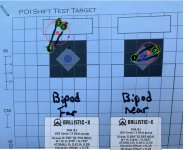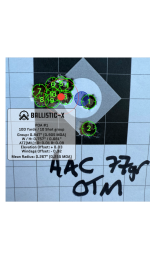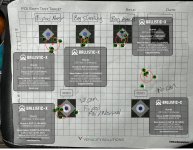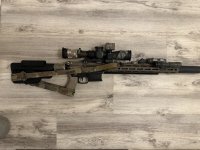I threw 1/2 moa out as an example and vague recollections of pics people posted on this thread, but maybe their shift was more.
I had to read your description three times. Still not sure I understand it. So to back brief: When you zero from a bipod your POI has a downward shift? And then when you shoot prone, mag supported you have double the downward shift? And then articulate that the handguard pressures are opposing between bipod supported(up) and mag supported with your support hand applying a heavy downward force?
Random question: zeroing with a bipod, downward shift. Shift from what? Did you already have a zero from a different position? And the downward shift was from a known good zero, but just from a different position?
As a complete aside to handguard flex, shooting mag supported in the prone is a really great tool for teaching NPOA(Natural Point of Aim). I developed an ARM (Advanced Rifle Marksmanship) POI based on the 400pt Rifle Aggregate. We had Tiger Swan come out to our unit as part of a PMT for an Afghanistan rotation. Their pistol instruction was on point and their rifle instruction was okay, but the 400pt Rifle Aggregate they used to teach their version of the rifle fundamentals is a great drill, although it could be pared down to a 300pt drill. You shoot 3 x 10rd, time fire strings on an IPSC target and your looking for A zone hits. From three different positions/ distances. 100m Kneeling, 200m Sitting, 300m Prone. The drill starts Standing, low ready, in kit, and you have 60 secs to go kneeling, fire 10rds with a mag change anywhere you want in the string. Move back to 200, Standing to sitting, 60secs, 10rds, one mag change, 300, Standing to prone, 10rds 1 mag change. Walk up and score all 30 shots for a total of 300pts. You can apply different scoring depending on the target you're using. B8 repair center, FBI Silhouette, etc.
When I teach shooting in the prone in kit, mag supported, you have 4 different axis that your barrel can try to point. Up, down, left and right. Place the mag and point the barrel,.if your too high on target you have to readjust the buttstock in your shoulder slightly up to adjust elevation. For left or right you pick up the gun and place the mag so the gun is pointing directly at the target, on sights so you don't have to move your body to get on target. And you do all this with your firing hand. You don't apply your support hand until you have a good NPOA. Once you do, you LIGHTLY apply your support hand as far out in the fore end as possible with your elbow providing support off the ground. The role of the support hand is to steady the long axis of the rifle only. If you're using your support hand to point the gun on target you're not shooting a NPOA. It's just there to quell the normal wobble zone with light guidance. Your body should aim the rifle naturally in target. Your firing hand pulls back into your shoulder and cheek pressure helps lock the gun in.
I use a VTAC sling to wrap in the kneeling and sitting. This allows the gun to rest in a position, in a NPOA. When you can shoot over 275 on a B8 repair center on this drill you're doing pretty good. And you're generally all inside the black. And as I think about it, the last time I shot it, I didn't have an obvious 10rd POI shift from, say sitting slung vs prone. You might want to try using your support hand as light pressure to steady and using your firing hand to provide the majority of pressure.







